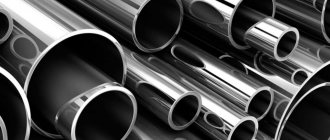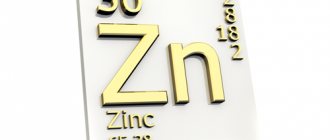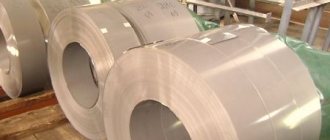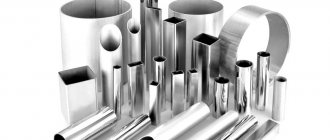We distinguish between galvanized and stainless steel
It is not easy to visually distinguish stainless steel from galvanized steel, since the difference in density is hardly noticeable (as is the appearance of the metal). The following types of tests must be used:
- For mechanical strength in the original state. Most grades of stainless steel have a tensile strength of at least 450 MPa. For galvanizing, this figure is much lower - up to 300...350 MPa.
- For hardness according to Brinell HB. For stainless steel, normal values are considered to be HB 230...300, for galvanized steel - HB 200...250.
- For plasticity. The specific force at which cracks appear on the workpiece is 170...230 MPa for galvanized steel, and 350...400 MPa for stainless steel.
If mechanical tests are not enough, chemical tests are carried out using hydrochloric acid. The method is based on the properties of zinc, which, when interacting with a galvanized sheet coating, actively releases hydrogen. A small drop of hydrochloric acid is enough for the galvanized surface to begin to bubble, and the zinc layer gradually disappears. The surface of stainless steel is chemically inactive.
Electromagnetic differences between galvanized and stainless steel can also be used for evaluation. If a magnet is attracted to the workpiece, then with a high degree of certainty we can say that it is galvanized steel, while most stainless steels are non-magnetic.
Zinc crystal lattice:
| 500 | Crystal cell | |
| 511 | Crystal grid #1 | |
| 512 | Lattice structure | Hexagonal close-packed |
| 513 | Lattice parameters | a = 2.6648 Å, c = 4.9468 Å |
| 514 | c/a ratio | 1,856 |
| 515 | Debye temperature | 234K |
| 516 | Name of space symmetry group | P63/mmc |
| 517 | Symmetry space group number | 194 |
Distinguishing aluminum from galvanization
In order to reduce the load on supporting structures, they are often made of aluminum. It is easy to distinguish aluminum from galvanized steel, especially if the buyer is not presented with a finished assembly, but with blanks made from rolled sheets or profiles. Main methods:
- By density/weight. The density of aluminum (2700 kg/m3) is almost three times less than the density of steel (7600...7900 kg/m3).
- In terms of surface hardness, aluminum is softer, and when scratched it will leave a deeper groove on a smooth surface.
- According to the effect on the tissue organs of the fingers. The thinnest film of aluminum dioxide upon frictional contact with wet skin of the hands will leave particles of aluminum on the surface of the fingers. When you touch them to a sheet of clean paper or cardboard, dark gray stripes will remain on it.
Externally, aluminum looks more silvery than steel, especially hot-rolled steel.
Nickel brass
Nickel brass is a copper-zinc alloy whose main alloying element is nickel. The latter has properties that significantly improve the performance of brass. It makes the alloy less susceptible to corrosion and refines the grain.
In industry, brass grade LN65-5 is often used. It contains 64-67% copper and 5-6% nickel, the rest is zinc. Impurities are allowed, the amount of which should not exceed 0.3%. It has increased mechanical properties, wear resistance, and can be processed. It is used to make condenser tubes for marine vessels, pressure gauges, and so on. There is another common alloy that contains 12-14% nickel, 26-30% zinc and 56-62% copper.
We distinguish between galvanized and non-galvanized steel
Both stainless steel and galvanized steel are characterized by good resistance to corrosion, so for short service life of structures (up to 10 years), the lower price of galvanized steel can be the decisive choice. It’s a different matter if the design is designed for a shorter period of use, and there is a reason to use ordinary steel. In such cases, it may be necessary to distinguish galvanized steel from non-galvanized steel.
A simple test will help you determine the difference between regular and galvanized steel:
- Prepare a solution of three parts table salt (not iodized!) and one part warm water.
- Dip a clean rag/cloth napkin into the solution and wipe the surface of the steel being tested with it.
- We keep the sample for 24 hours in a normal room at room temperature (you can’t leave it in the sun).
- We inspect the sample: if there are no traces of rust on it, and the surface texture is not uniform in the treated and untreated areas, then this is galvanized steel.
The basis of the test is that as a result of galvanic galvanizing - hot or cold - zinc actively penetrates deep into the base metal, introducing itself into its structure, which acquires anti-corrosion resistance. Ordinary steel does not have such a protective coating, so a saturated saline solution activates the oxidation process with the formation of light red iron oxide.
Another way to distinguish galvanized steel from non-galvanized steel is based on the different magnetic properties of the metals. Zinc, for example, is non-magnetic, so by applying a regular magnet to the unpainted surface of a workpiece, you can determine whether it contains zinc or not.
If the surface of the workpiece is already painted with heat-resistant paint, a magnet will not help. Laboratory testing is required. The greatest accuracy will be obtained by testing for electron paramagnetic resonance (EPR). EPR shows the content of material molecules on an oscilloscope, so galvanized steel will have a high zinc content on the outer surface and its presence in the inner layers. When painting, no zinc will be found in the coating.
Another method is to take a microphotograph of a ground cross-section of the sample. When galvanizing, three intermetallic layers are clearly visible in the structure, which are absent in conventional steels.
In conclusion, we will present an exotic method - you just need to... lick the steel surface. Galvanized steel, unlike ordinary steel, has a chalky aftertaste, and a very distinct one.









